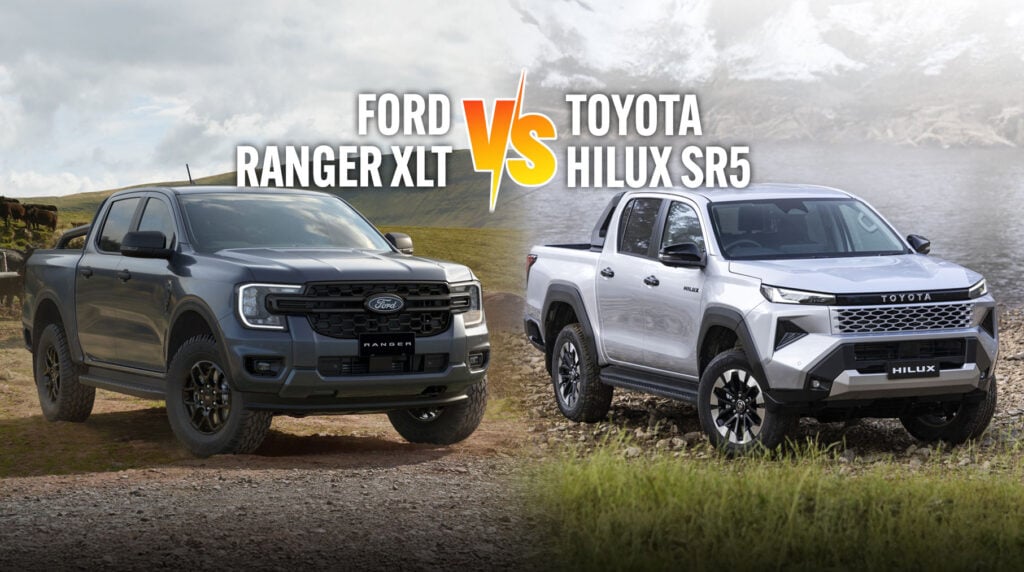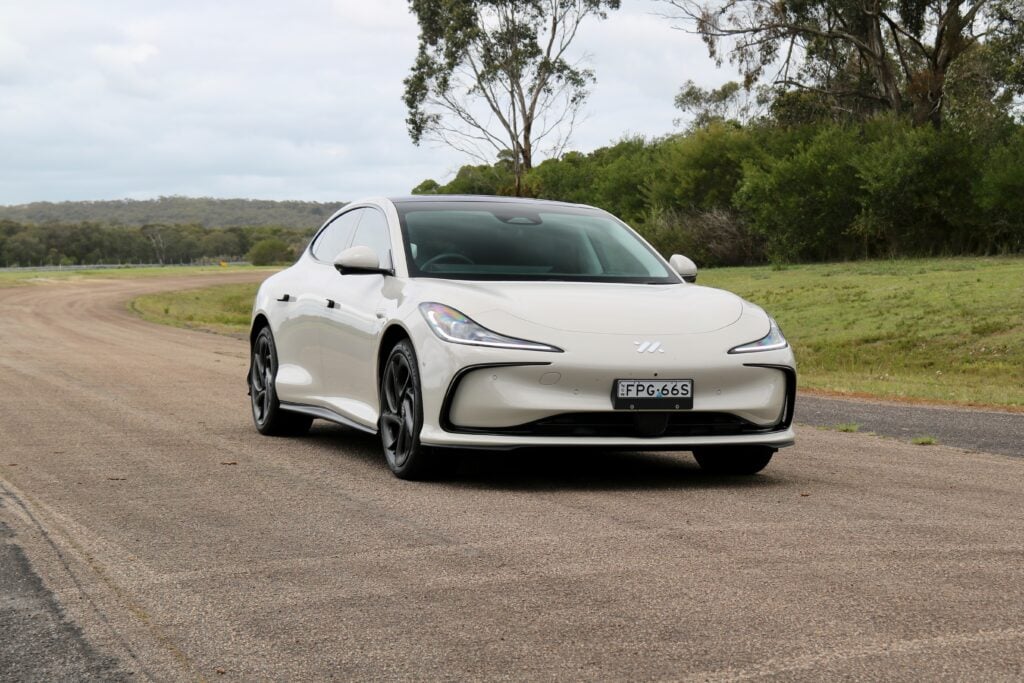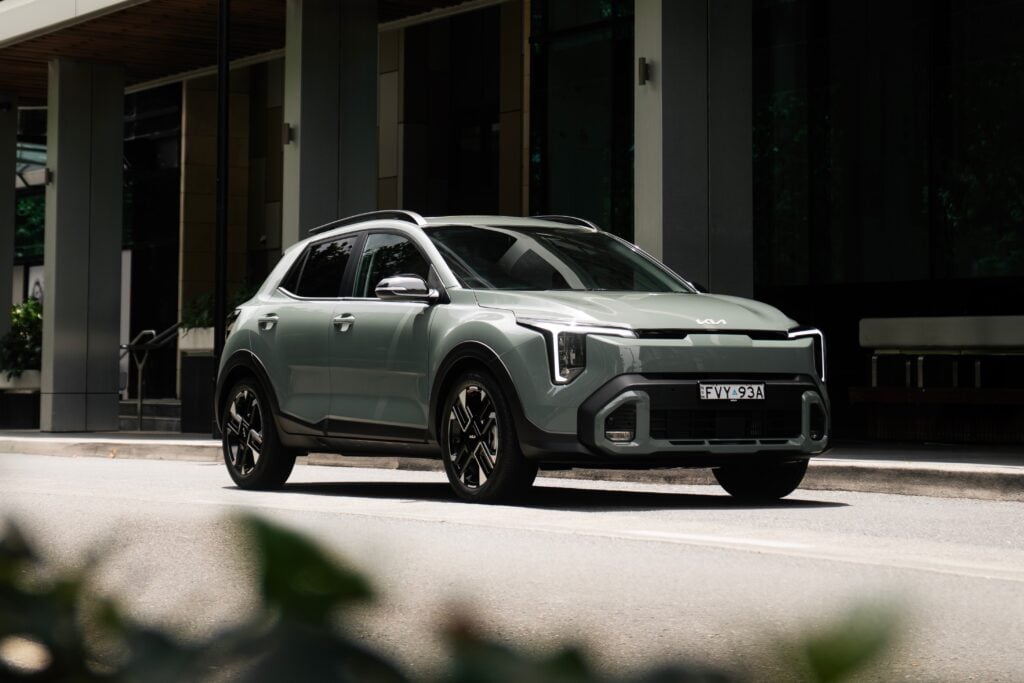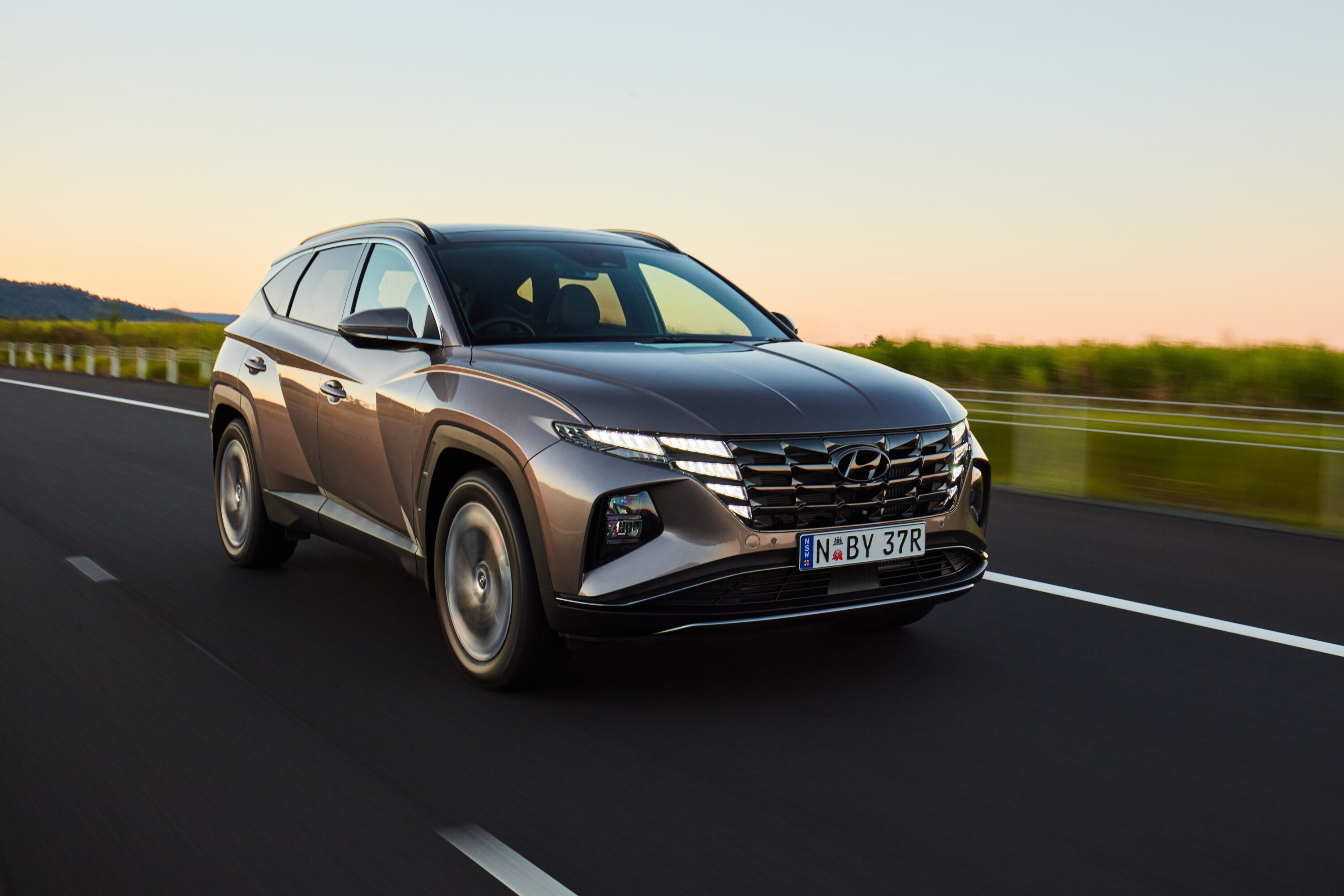
Score breakdown
Things we like
- Sharp interior and exterior design
- N-Line looks even sharper
- Interior space and comfort
- Boot space and practicality
Not so much
- Lacklustre petrol powertrains
- Busy ride on country roads
- Over-zealous lane-keep assist
Anyone who reckons all SUVs look the same probably hasn’t seen the fourth-generation Hyundai Tucson.
When it launched in 2020, just six years separated this Tucson and the bland second-generation model known here as the ix35.
Three years on, the Tucson is still one the most striking-looking mainstream SUV models on the market, with its ‘Sensuous Sportiness’ design language bringing more angles than an origami swan including a sharp shoulder line, bulging wheel surrounds and bold character lines including a distinctive mark-of-Zorro-like Z-shape on the back door.
But beauty is in the eye of the beholder and, in the case of the Tucson, it doesn’t extend too far beyond skin deep.
A facelifted Tucson launched into Australia in June 2024. This range review has been updated to reflect the updates and changes.
JUMP AHEAD
- Hyundai Tucson pricing
- What body styles are available with the Tucson?
- What features are in every Tucson?
- What key features do I get if I spend more?
- How safe is the Hyundai Tucson?
- How comfortable & practical is the Tucson?
- How much boot space does the Tucson offer?
- I like driving, will I enjoy the Tucson?
- Which Tucson engine uses the least fuel?
- What is the Tucson’s towing capacity?
- How long is the warranty & what are the Tucson’s servicing costs?
- Which version of the Tucson does Wheels recommend?
- What are the Hyundai Tucson’s key rivals?
Hyundai Tucson pricing
| Variant | Price |
|---|---|
| Hyundai Tucson 2.0L SUV FWD | $39,100 |
| Hyundai Tucson Elite 2.0L SUV FWD | $44,100 |
| Hyundai Tucson N Line 1.6L SUV FWD | $45,100 |
| Hyundai Tucson 1.6L SUV FWD Hybrid | $45,100 |
| Hyundai Tucson Elite 1.6L SUV FWD | $46,100 |
| Hyundai Tucson Elite 1.6L SUV 4WD | $48,600 |
| Hyundai Tucson Elite N Line 1.6L SUV FWD | $48,600 |
| Hyundai Tucson N Line 1.6L SUV FWD Hybrid | $49,100 |
| Hyundai Tucson Elite 1.6L SUV FWD Hybrid | $50,100 |
| Hyundai Tucson Elite N Line 1.6L SUV 4WD | $51,100 |
| Hyundai Tucson Elite 1.6L SUV 4WD Hybrid | $52,600 |
| Hyundai Tucson Elite N Line 1.6L SUV FWD Hybrid | $52,600 |
| Hyundai Tucson Elite N Line 1.6L SUV 4WD Hybrid | $55,100 |
| Hyundai Tucson Premium 1.6L SUV 4WD | $55,600 |
| Hyundai Tucson Premium N Line 1.6L SUV 4WD | $57,100 |
| Hyundai Tucson Premium 1.6L SUV 4WD Hybrid | $59,600 |
| Hyundai Tucson Premium N Line 1.6L SUV 4WD Hybrid | $61,100 |
| Prices exclude on-road costs |
What body styles are available with the Tucson?
Like all of its rivals, the Hyundai Tucson is a five-door SUV only, with five seats.
The Tucson drives either its front wheels (FWD) or all four wheels (AWD), depending on the version chosen. It is classed as a medium SUV, in the volume-selling segment.
Powertrains include a standard non-turbo 2.0-litre petrol four-cylinder engine, along with a 1.6-litre turbo petrol four in regular and electric-assisted hybrid forms – the latter entering as a rival to Toyota’s popular RAV4 Hybrid.
The Tucson has dropped its 2.0-litre diesel in the process, but buyers keen on that mill can look to its brother under the skin, the Kia Sportage.
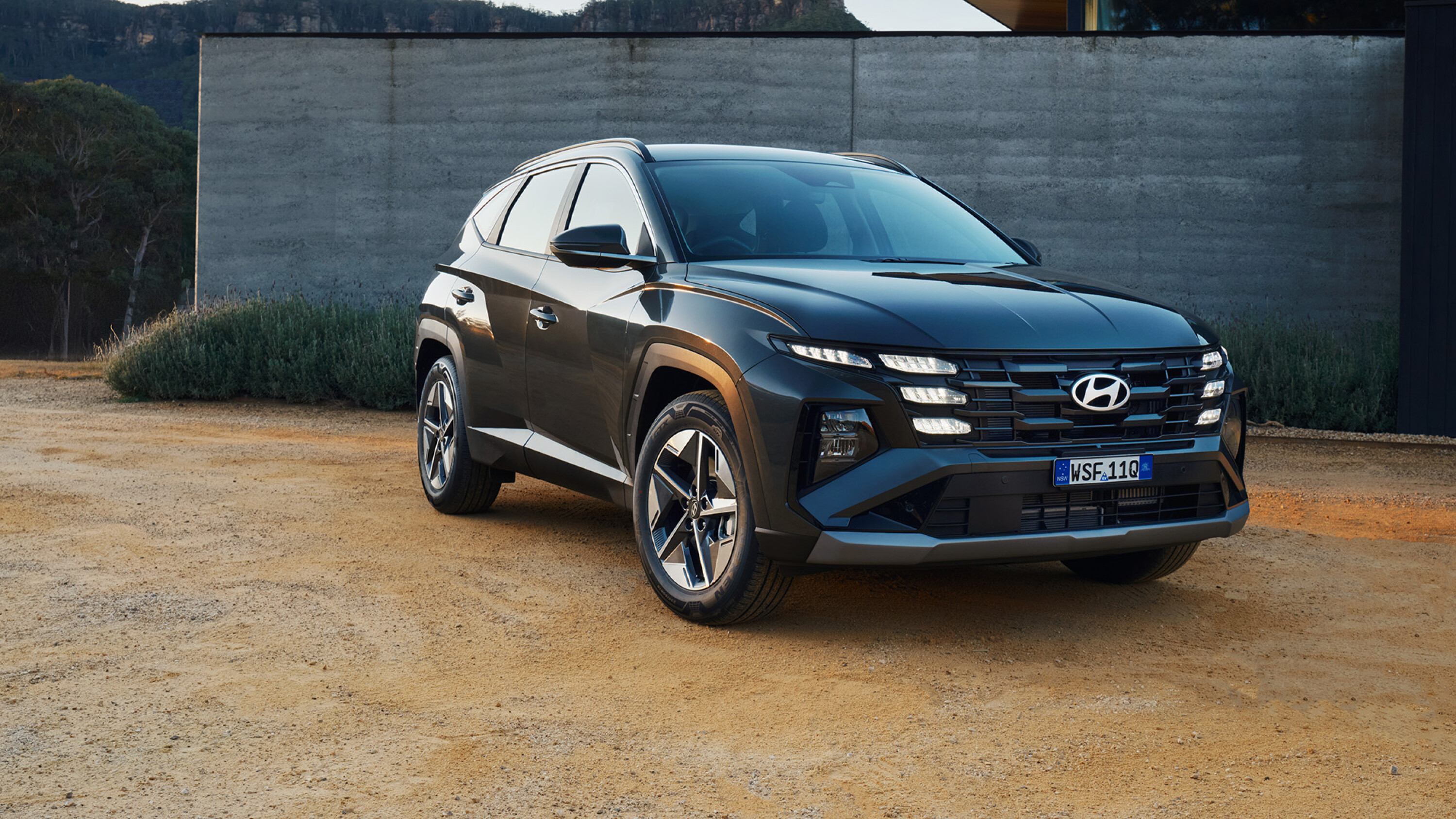
What features are in every Tucson?
The features listed below are standard in the entry-level model and will appear in higher-grade variants unless replaced with more premium equivalent features.
Entry level: Tucson 2.0L FWD
As the name suggests, the cheapest Tucson comes with front-wheel drive (FWD) and the four-cylinder 2.0-litre ‘SmartStream’ naturally-aspirated petrol engine, with a six-speed automatic transmission.
It’s decked out with 18-inch alloy wheels, including a full-sized spare, while the interior features manually adjusted cloth seats, a new 12.3-inch main display, and wireless connectivity for Apple Carplay and Android Auto.
| 2025 Hyundai Tucson standard features | |
|---|---|
| Cloth seats | Dual-zone climate control with 6.6-inch touchscreen, temperature dials (new) |
| 18-inch machined alloy wheels (up from 17) | 15W Wireless phone charging |
| LED headlights and tail-lights (previously Elite & up) | Four USB-C ports |
| 12.3-inch main display (up from 10.25in) | Bluelink phone app connectivity |
| New ccNC infotainment & OTA updates | Six-speaker audio |
| Apple CarPlay & Android Auto (both wireless & wired) | Keyless entry and start (new) |
| 4.2-inch driver display between standard gauges | One-touch up/down windows front and rear |
| 2025 Hyundai Tucson standard safety | |
|---|---|
| Autonomous emergency braking | Crosswind stability control |
| Lane-keep assist | Rear cross-traffic alert with braking support |
| Lane-centring assist | Rear parking sensors |
| Adaptive cruise control with stop and go | Front parking sensors (previously Elite & up) |
| Blind-spot monitoring with braking support | Rear occupant alert (‘logic type’) |
| Traffic sign recognition | Door exit warning |
Buyers of the base model can also up their spend to add the N Line package, detailed below.
| 2025 Hyundai Tucson N-Line pack for base model ($4-6K) | |
|---|---|
| 1.6-litre turbo-petrol engine for non-hybrid version (replacing 2.0 petrol) | 12.3-inch drive display |
| Shift-by-wire gear selector | N Line interior accents |
| 19-inch N Line alloys | N Line leather and suede seat upholstery, red highlights |
| N Line exterior styling, body-coloured cladding | Alloy pedal covers |
| Adaptive projector-type LED headlights with auto high beam | N Line door sill plates |
| LED reversing lights | |
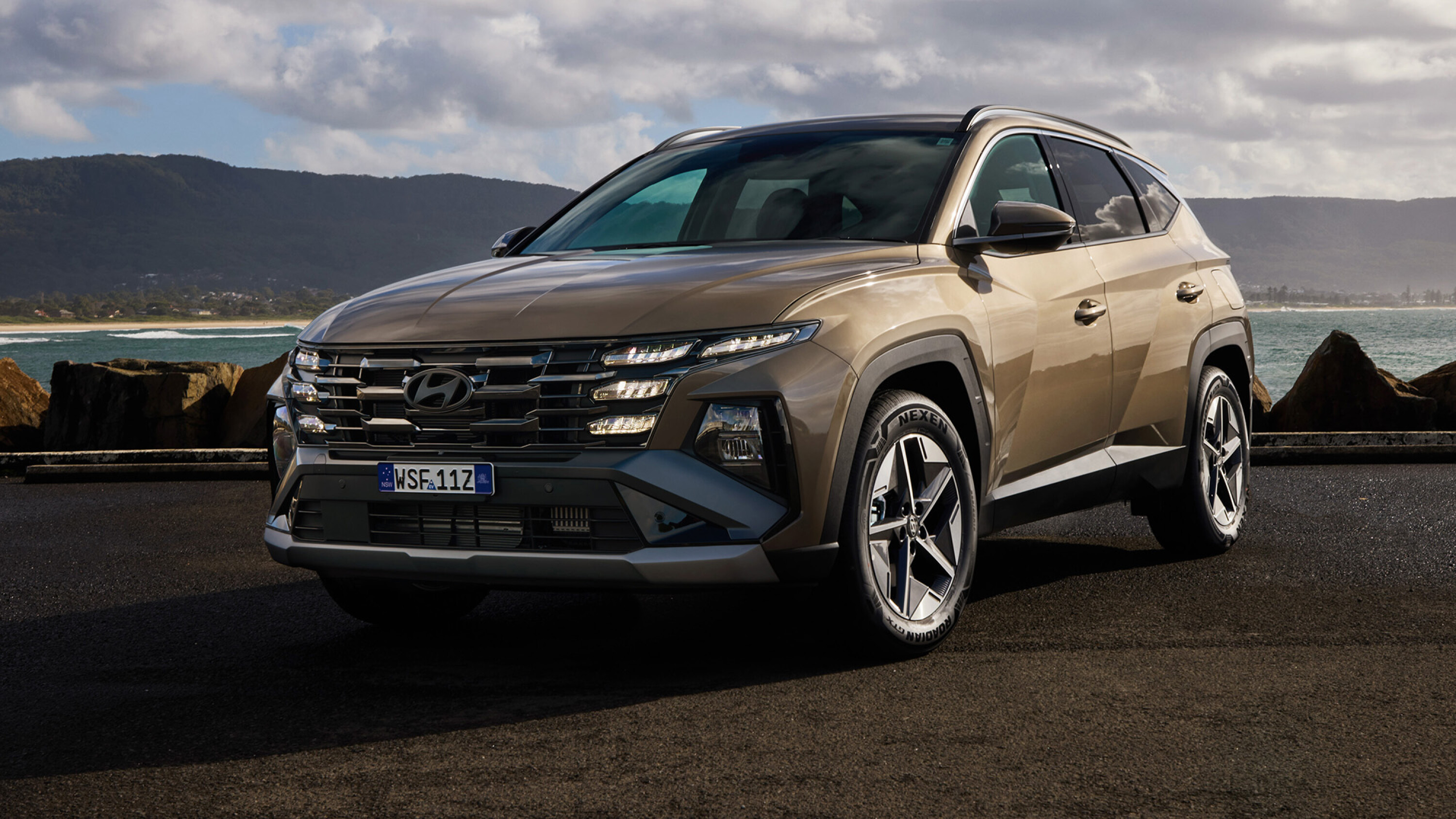
What key features do I get if I spend more?
Tucson Elite
Stepping up to the mid-spec Elite brings a bunch of extras and more powertrain choices.
Tucson Elite powertrains
- 115kW/192Nm 2.0 naturally aspirated petrol four
- 132kW/265Nm 1.6 turbo petrol four
- 169kW/350Nm 1.6 turbo petrol-electric hybrid four
| Tucson Elite variants | Price |
|---|---|
| Hyundai Tucson Elite 2.0L SUV FWD | $44,100 |
| Hyundai Tucson Elite 1.6L SUV FWD | $46,100 |
| Hyundai Tucson Elite 1.6L SUV 4WD | $48,600 |
| Hyundai Tucson Elite N Line 1.6L SUV FWD | $48,600 |
| Hyundai Tucson Elite 1.6L SUV FWD Hybrid | $50,100 |
| Hyundai Tucson Elite N Line 1.6L SUV 4WD | $51,100 |
| Hyundai Tucson Elite 1.6L SUV 4WD Hybrid | $52,600 |
| Hyundai Tucson Elite N Line 1.6L SUV FWD Hybrid | $52,600 |
| Hyundai Tucson Elite N Line 1.6L SUV 4WD Hybrid | $55,100 |
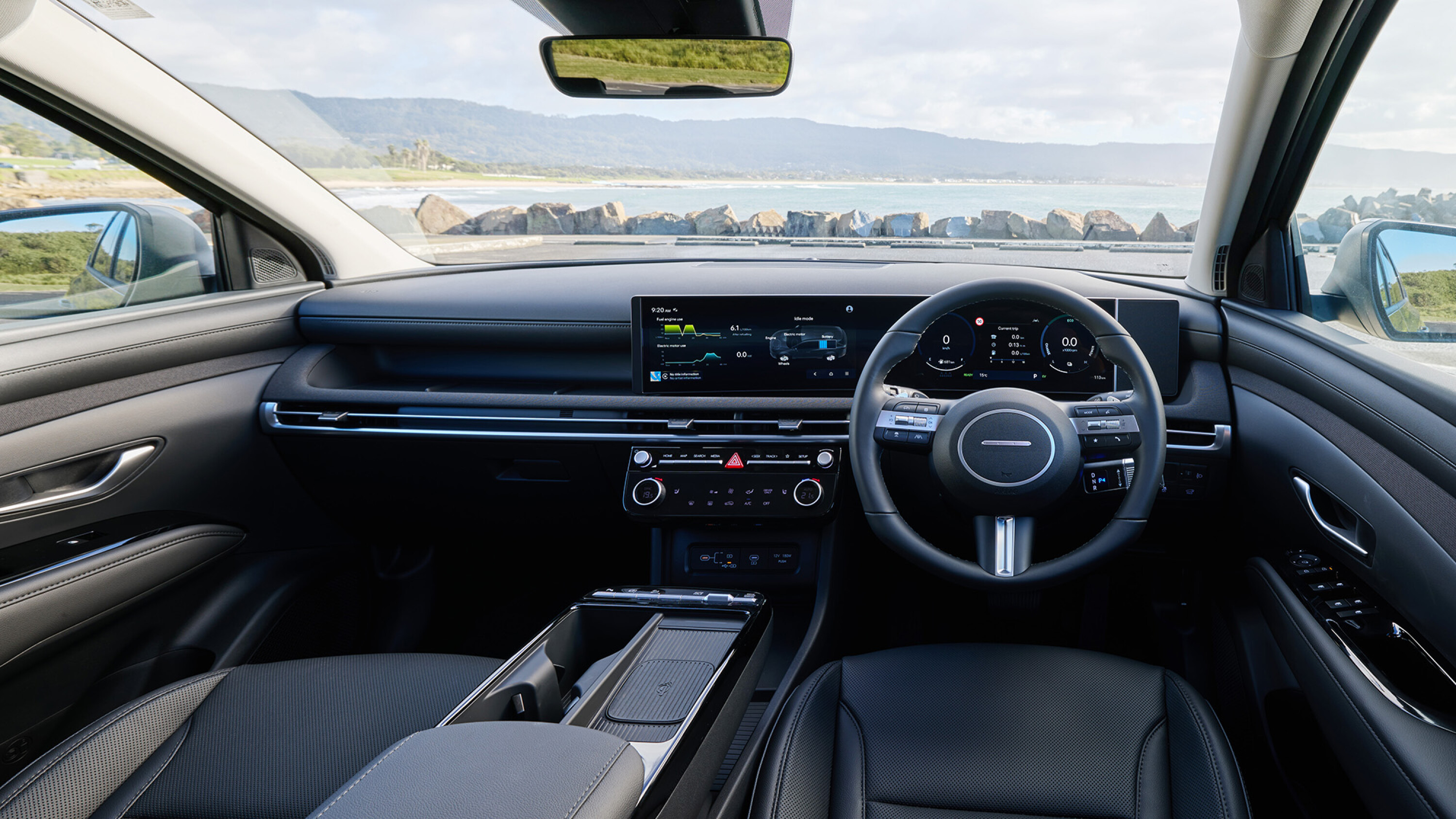
Key highlights include a 12.3-inch digital driver display and Highway Driving Assist, which integrates adaptive cruise control, lane centring, and automatic lane changes for enhanced driving support.
There’s also a power-operated tailgate, heated front seats and a heated steering wheel and leather-accented seats. Full upgrades listed below.
| 2025 Hyundai Tucson Elite (over base model) | |
|---|---|
| 12.3-inch driver display | Rain-sensing wipers |
| Dark chrome front grille with themed LEDs | Alloy door sill plates |
| Power-operated tailgate (previously Premium only) | Rear privacy glass |
| Heated front seats | Shift-by-wire gear selector & paddle shifters (1.6 turbo only) |
| Heated steering wheel (previously Premium only) | Highway Driving Assist with adaptive cruise control, lane centring, auto lane changes |
| Leather-accented seats | Rear occupant alert with sensors in seat bases |
| Power-adjustable driver’s seat | |
| 2025 Hyundai Tucson Elite N-Line (1.6 hybrid only) u2013u00a0$2500 | |
|---|---|
| 19-inch N Line alloy wheels | N Line interior highlights |
| N Line exterior styling with body-coloured cladding | N Line-branded leather and suede seat upholstery with red highlights |
| Adaptive projector-type LED headlights with auto high beam | Alloy pedal covers |
| LED reversing lights | N Line-branded door sill plates |
Tucson Premium
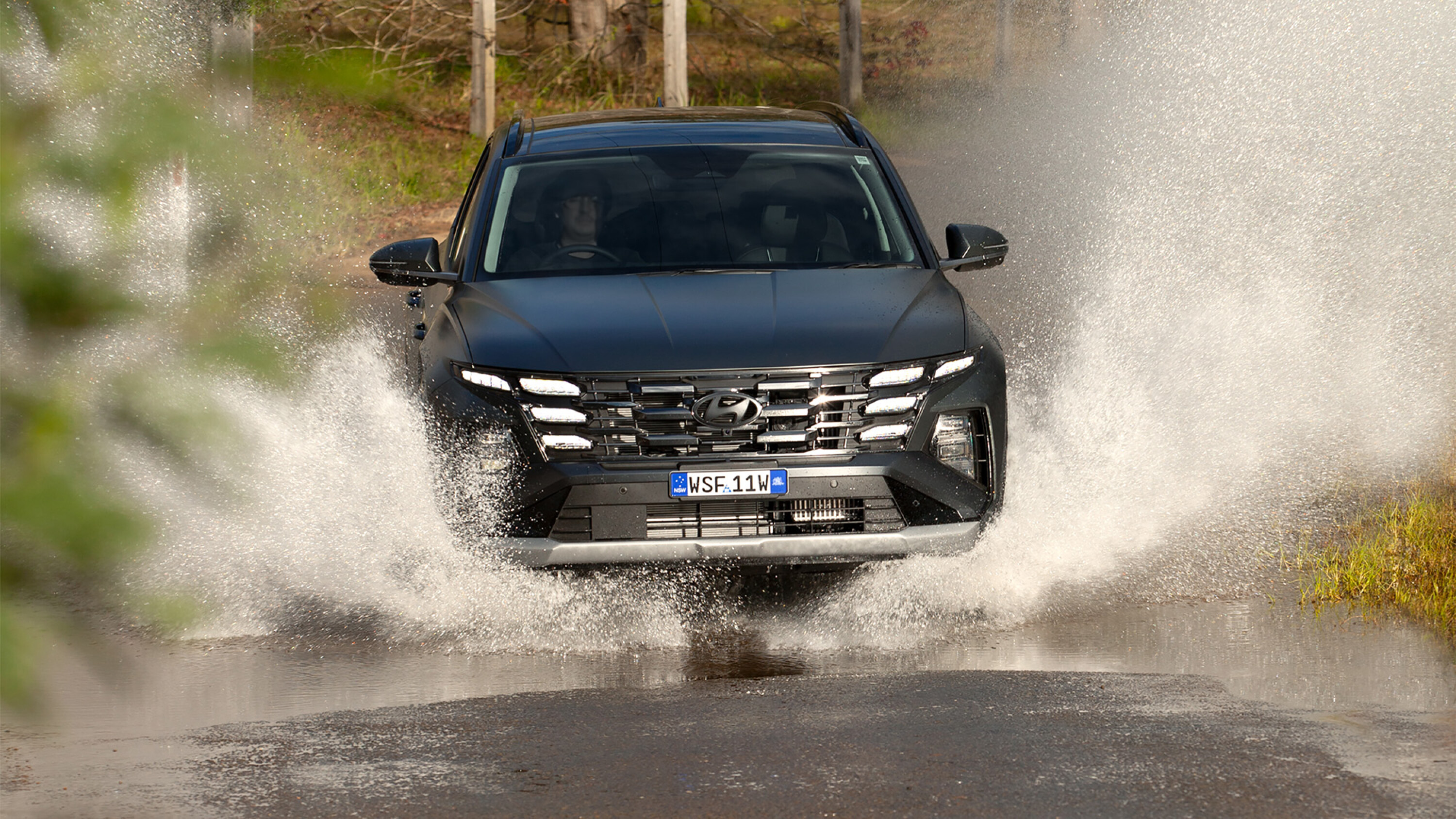
| Tucson Premium variants | Price |
|---|---|
| Hyundai Tucson Premium 1.6L SUV 4WD | $55,600 |
| Hyundai Tucson Premium N Line 1.6L SUV 4WD | $57,100 |
| Hyundai Tucson Premium 1.6L SUV 4WD Hybrid | $59,600 |
| Hyundai Tucson Premium N Line 1.6L SUV 4WD Hybrid | $61,100 |
| Prices exclude on-road costs |
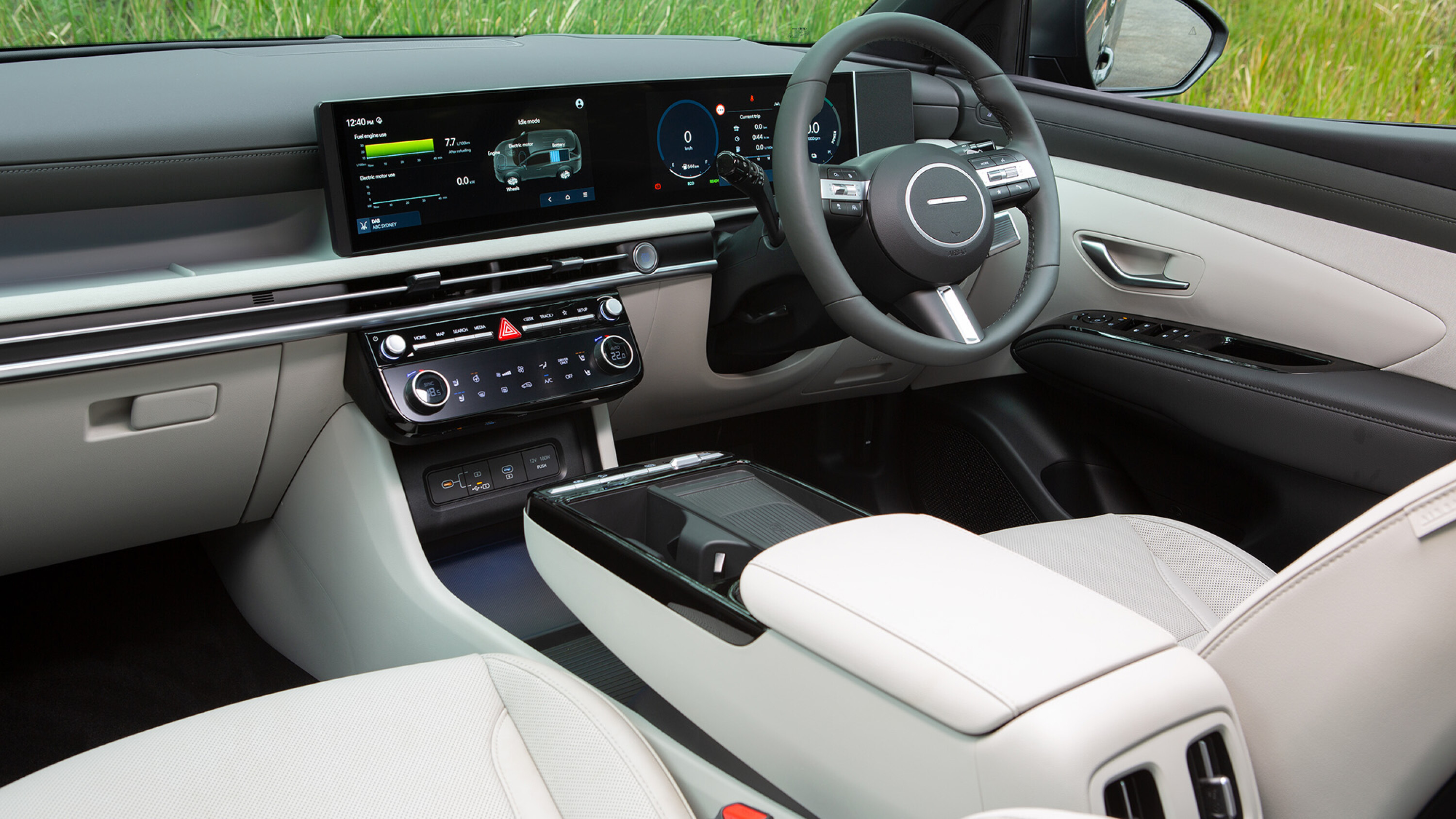
The Tucson Premium brings even more desirable extras, including:
| 2025 Hyundai Tucson Premium (over Elite) | |
|---|---|
| 19-inch alloy wheels | Ambient interior lighting |
| Panoramic glass sunroof | Eight-speaker Bose premium sound system |
| Adaptive projector-type LED headlights with auto high beam | Blind-spot cameras (known as Blind-Spot View Monitor) |
| 12-inch head-up display | 360-degree camera |
| Ventilated front seats | Low-speed rear autonomous emergency braking for car parks |
| Power-adjustable front passenger seat | Side parking sensors |
| Memory for driver’s seat | |
Tucson Premium N-Line
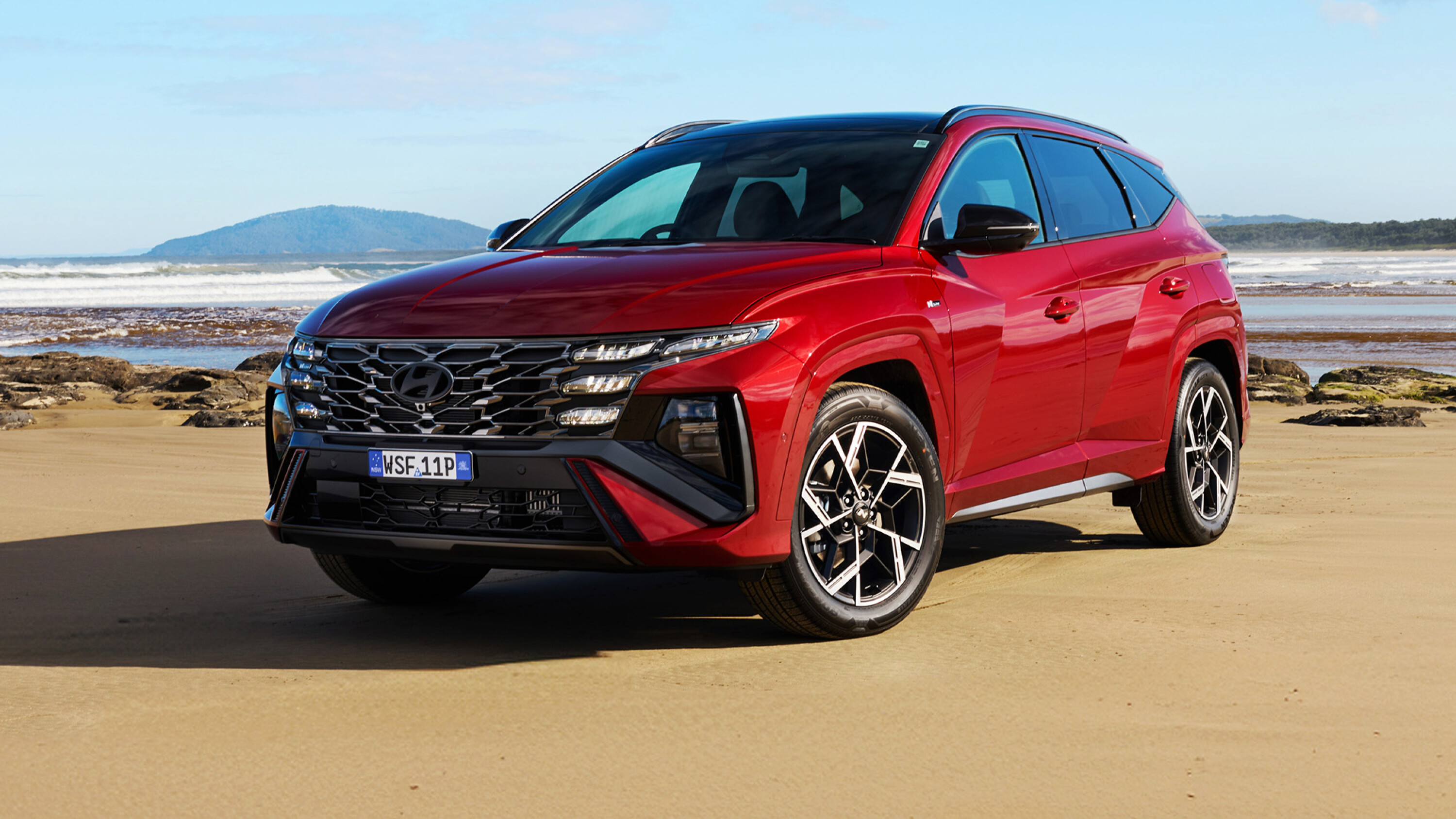
| 2025 Hyundai Tucson Premium N-Line u2013 $1500 | |
|---|---|
| 19-inch N Line alloy wheels | N Line-branded leather and suede seat upholstery with red highlights |
| N Line exterior styling with body-coloured cladding | Alloy pedal covers |
| LED reversing lights | N Line-branded door sill plates |
| N Line interior highlights | |
How safe is the Hyundai Tucson?
The Hyundai Tucson has a five-star ANCAP safety rating, based on testing conducted in 2021. This applies to all variants.
It received a score of 86 per cent for adult occupant protection, 87 per cent for child occupant protection, 66 per cent for vulnerable road user protection, and 70 per cent for safety assist technology, which includes:
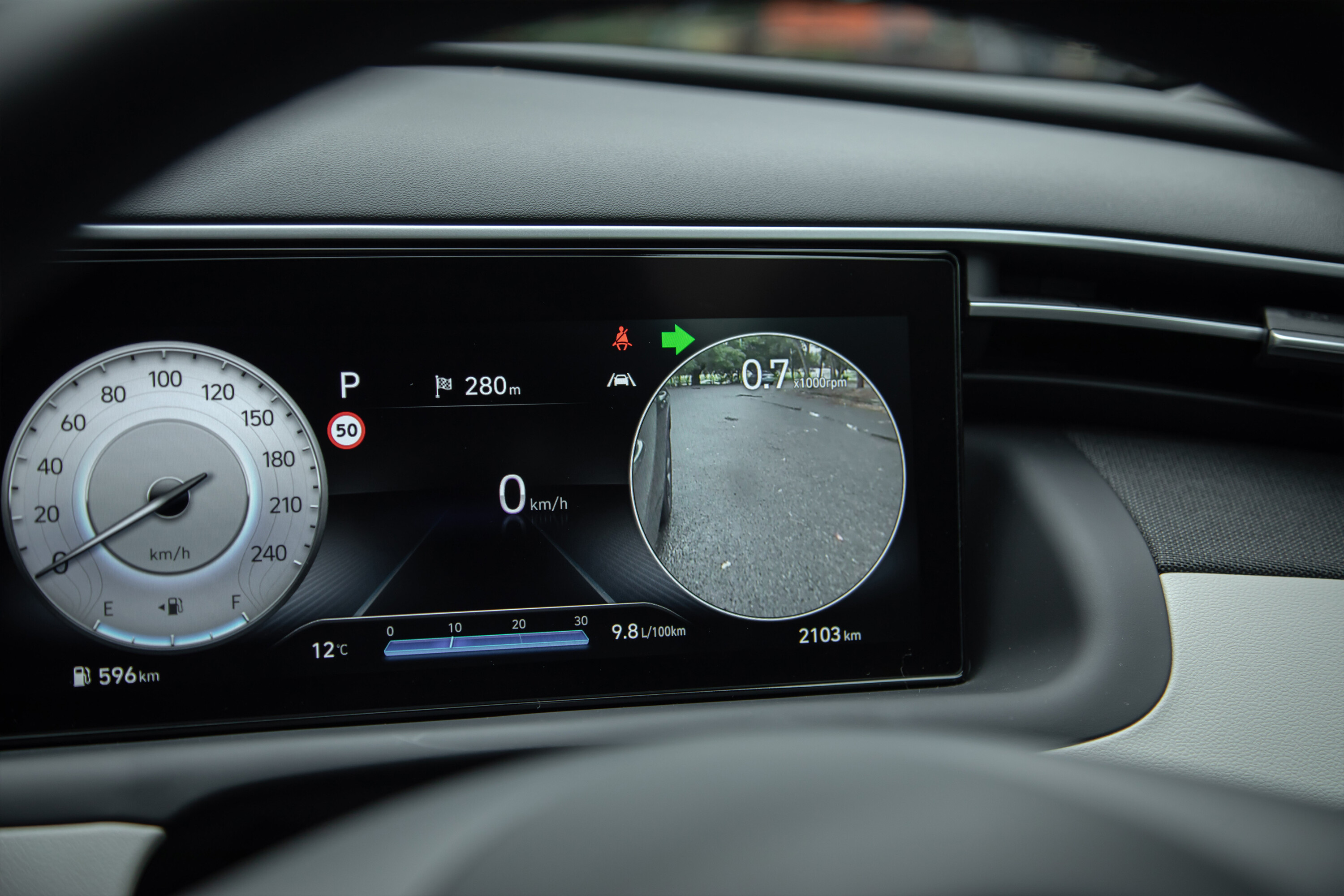
| 2025 Hyundai Tucson standard safety | |
|---|---|
| Autonomous emergency braking | Crosswind stability control |
| Lane-keep assist | Rear cross-traffic alert with braking support |
| Lane-centring assist | Rear parking sensors |
| Adaptive cruise control with stop and go | Front parking sensors (previously Elite & up) |
| Blind-spot monitoring with braking support | Rear occupant alert (‘logic type’) |
| Traffic sign recognition | Door exit warning |
How comfortable and practical is the Hyundai Tucson?
If someone is won over by the Tucson in a showroom it’s likely to be when they slide into the cabin.
The fit and finish are excellent and, even in the entry-level Tucson, you won’t find any hard plastics up front higher than the door armrests.
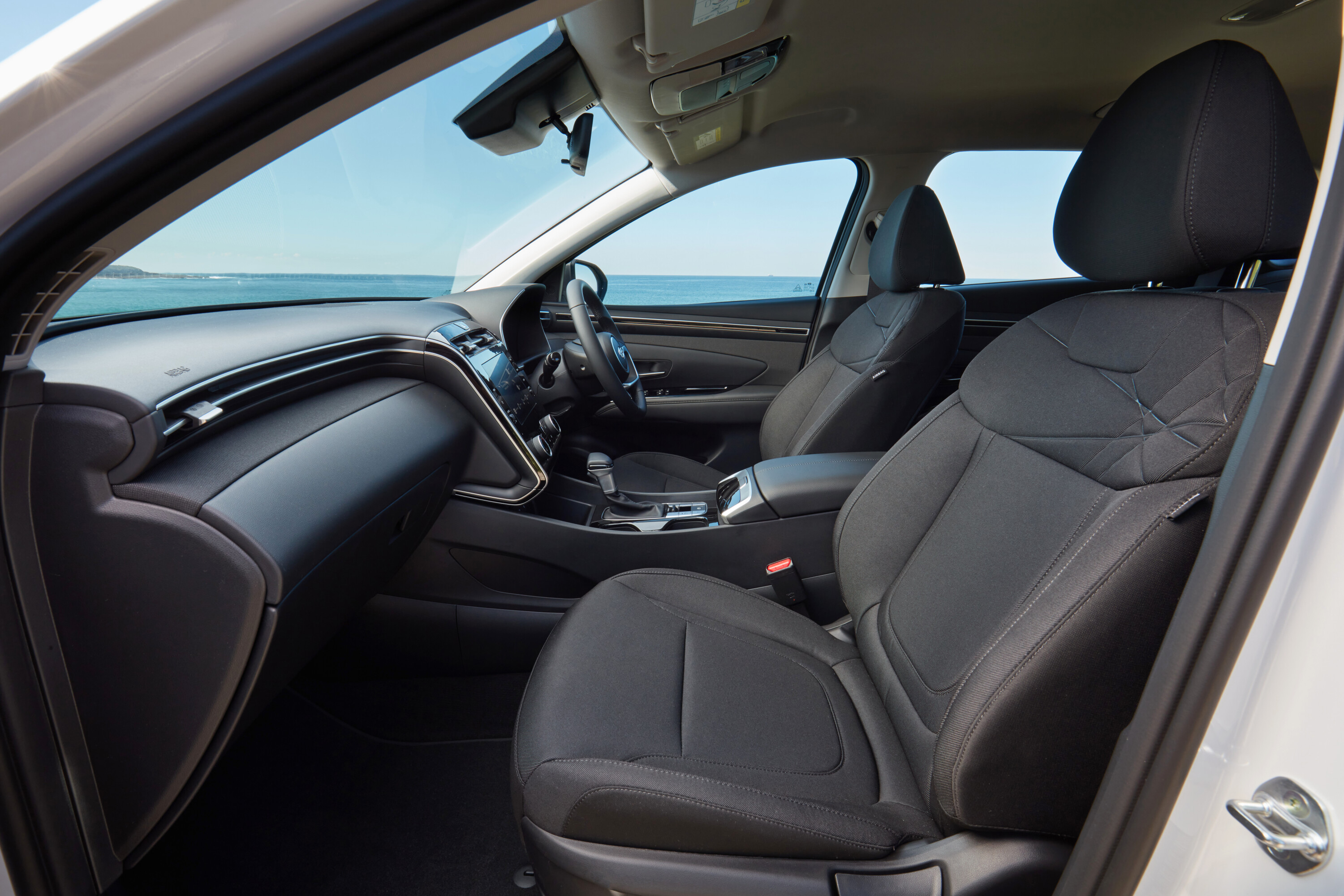
In the Premium, everything looks very premium, particularly with the leather upholstery trims, which are a $295 option over the standard black leather.
The front seats in all variants are comfortable.
Like the dashboard, the two-tier centre console has no protruding clutter, with even the shift-by-wire gear selector now positioned behind the steering wheel on 1.6 turbo petrol models.
There’s a decent-sized storage bin, two cup holders and a wireless phone charging pad that’s slightly tilted to allow for ventilation underneath and prevent the device from overheating.
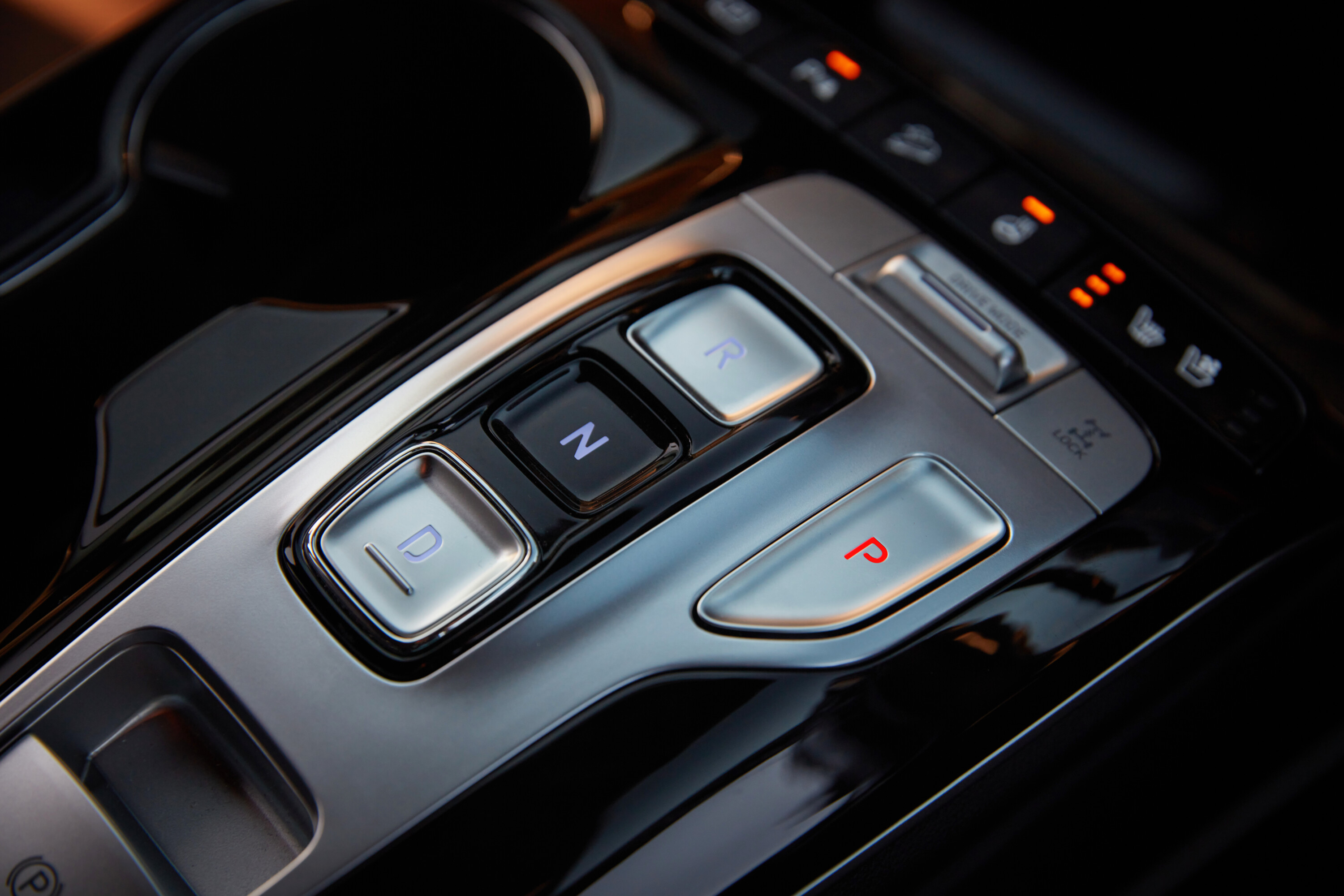
Rear space and comfort
The Tucson’s 2755mm wheelbase brings plenty of leg and knee room and there’s a nice gap under the front seats to fit your feet.
All three rear seats are comfortable and despite the swept-back roofline headroom isn’t too bad either – even in versions that have a sunroof.
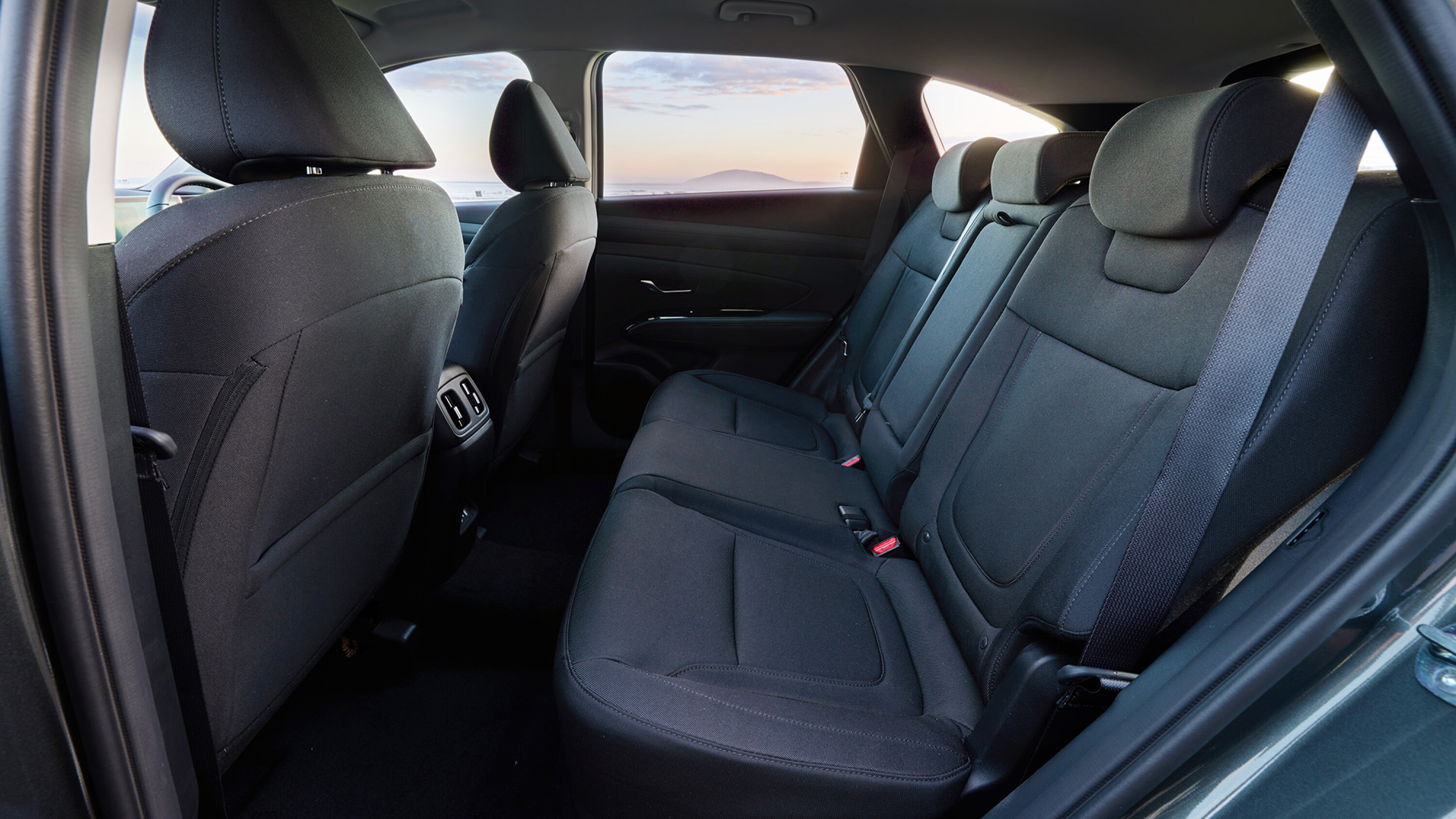
With two rear passengers, there’s a fold-down centre armrest with two cup holders.
Fitting three adults across the bench might be a bit of a squeeze, but whoever cops the middle will be pleased to see that the Tucson has a very shallow transmission tunnel that allows for reasonable legroom.
With two rear passengers, there’s a fold-down centre armrest with two cup holders. Other rear storage options include map pockets behind the front seats and pokey little door bins designed to take a bottle. Rear seat passengers also get air vents and there are two USB sockets.
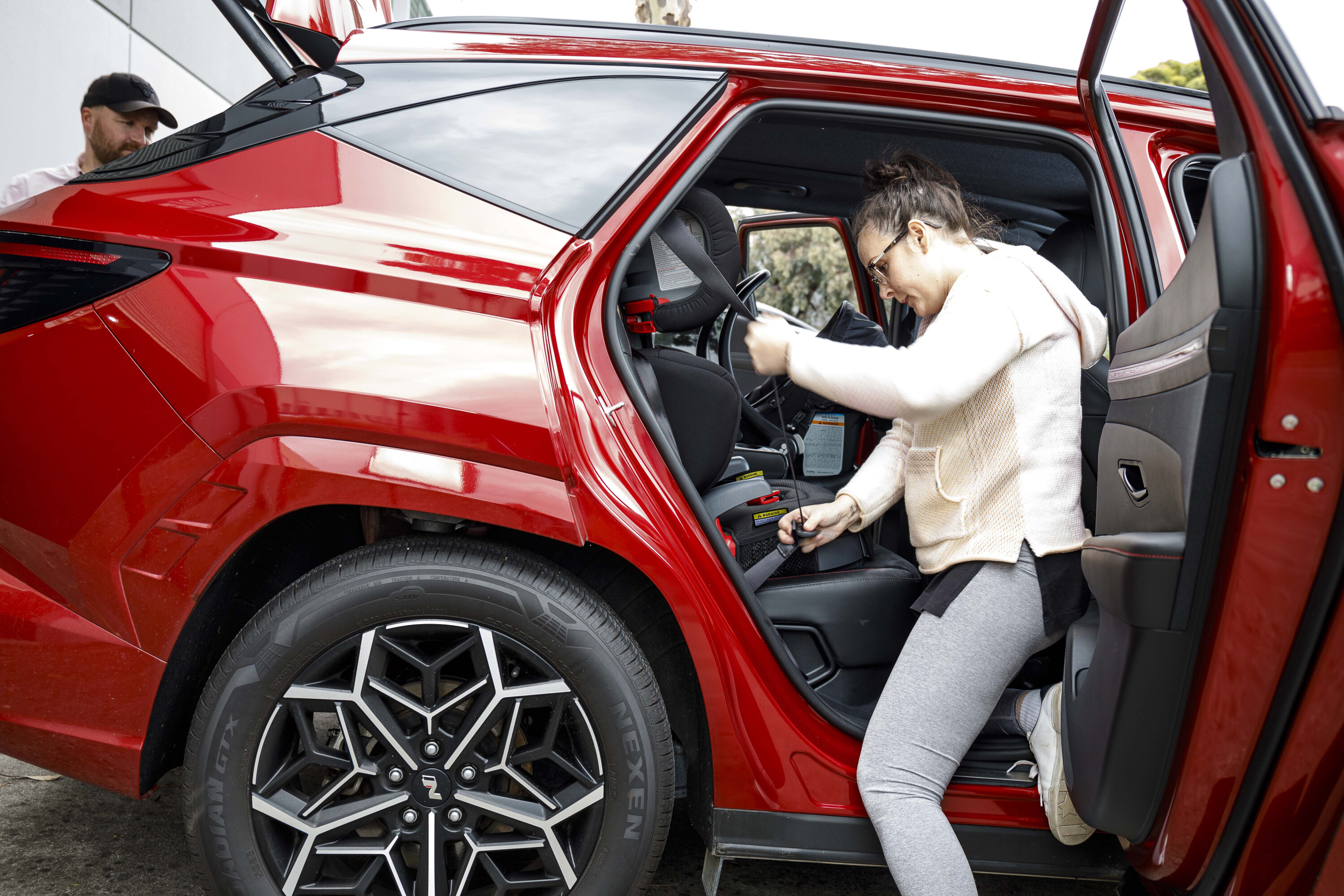
You’ll have no issues fitting three younger people across the back and if you need to put them in child seats there are ISOFIX anchor points at the outboard seats and three top tethers.
However, fitting the top tether on child seats can be difficult due to a narrow gap between the back of the second-row seats and the retractable parcel shelf.
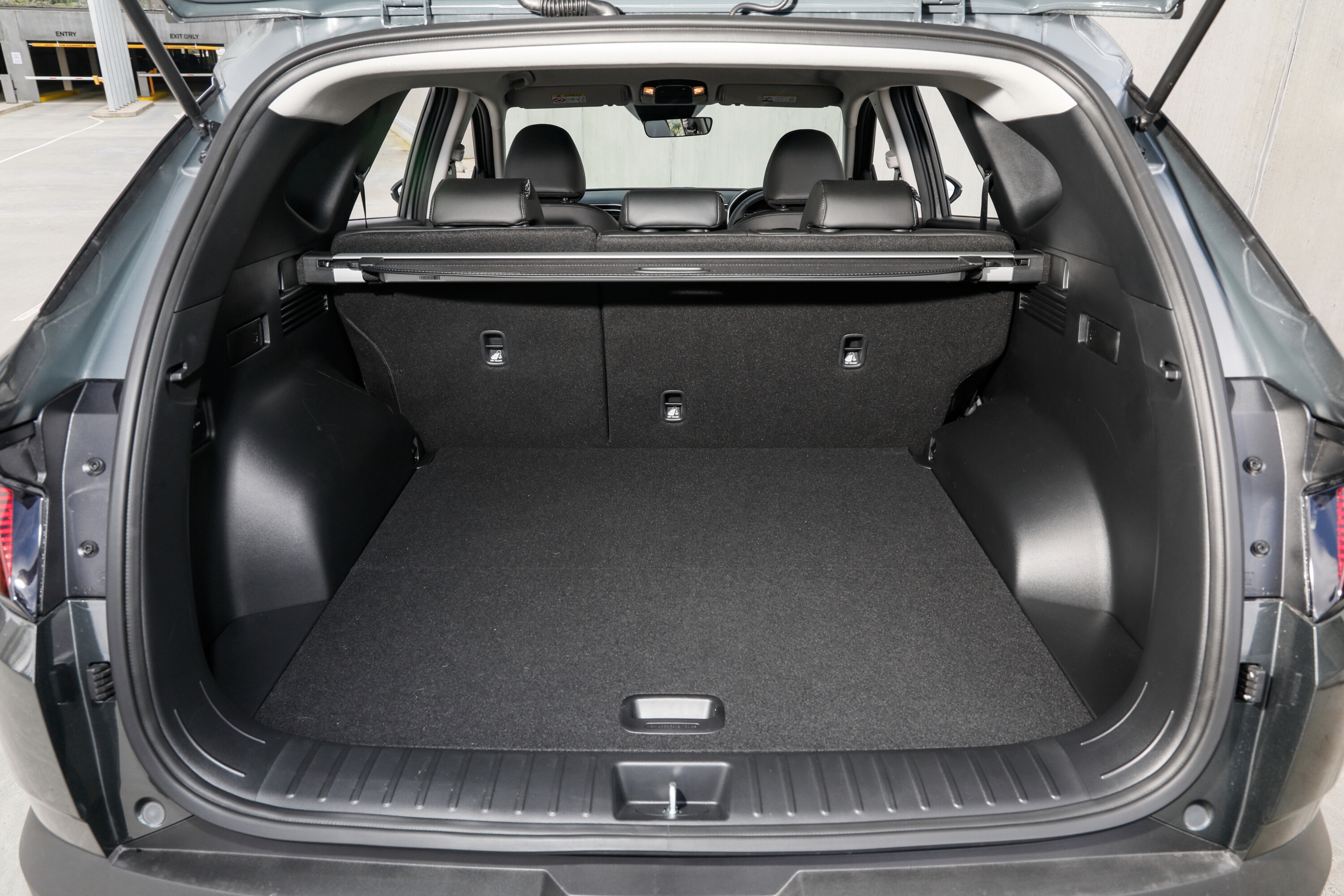
How much boot space does the 2025 Hyundai Tucson offer?
With the rear seats up, the boot holds 539 litres, making it one of the biggest in a medium SUV.
The Tucson has a full-sized spare wheel under the boot floor, so it compares well with the Toyota RAV4, which holds 542 litres with the optional full-sized spare.
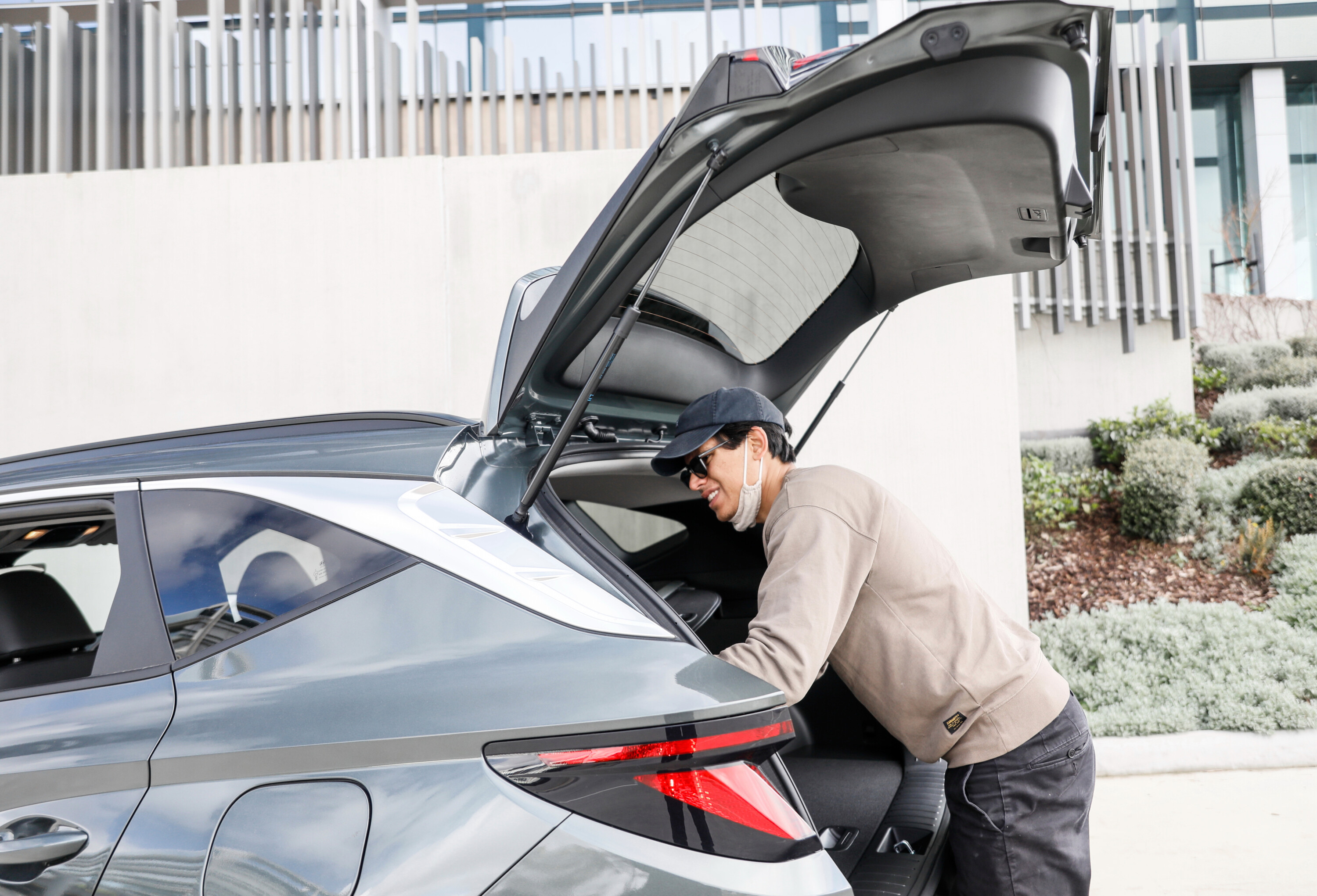
Folding the Tucson’s 60:40 split rear seatbacks down brings up to 1860 litres.
The Tucson’s tailgate opens nice and high so you won’t hit your head, and there’s a 12-volt outlet plus remote seatback releases.
I like driving, will I enjoy the Hyundai Tucson?
Depending on the engine you choose… yes or no.
Even if performance is down the bottom of your list, there will be times when you’ll find the SmartStream G2.0 engine wanting, particularly when tackling hills.
This is essentially the same engine found in the i30 Sedan, but it’s pulling an extra 200kg, which makes it a little revvy when you put your foot down.
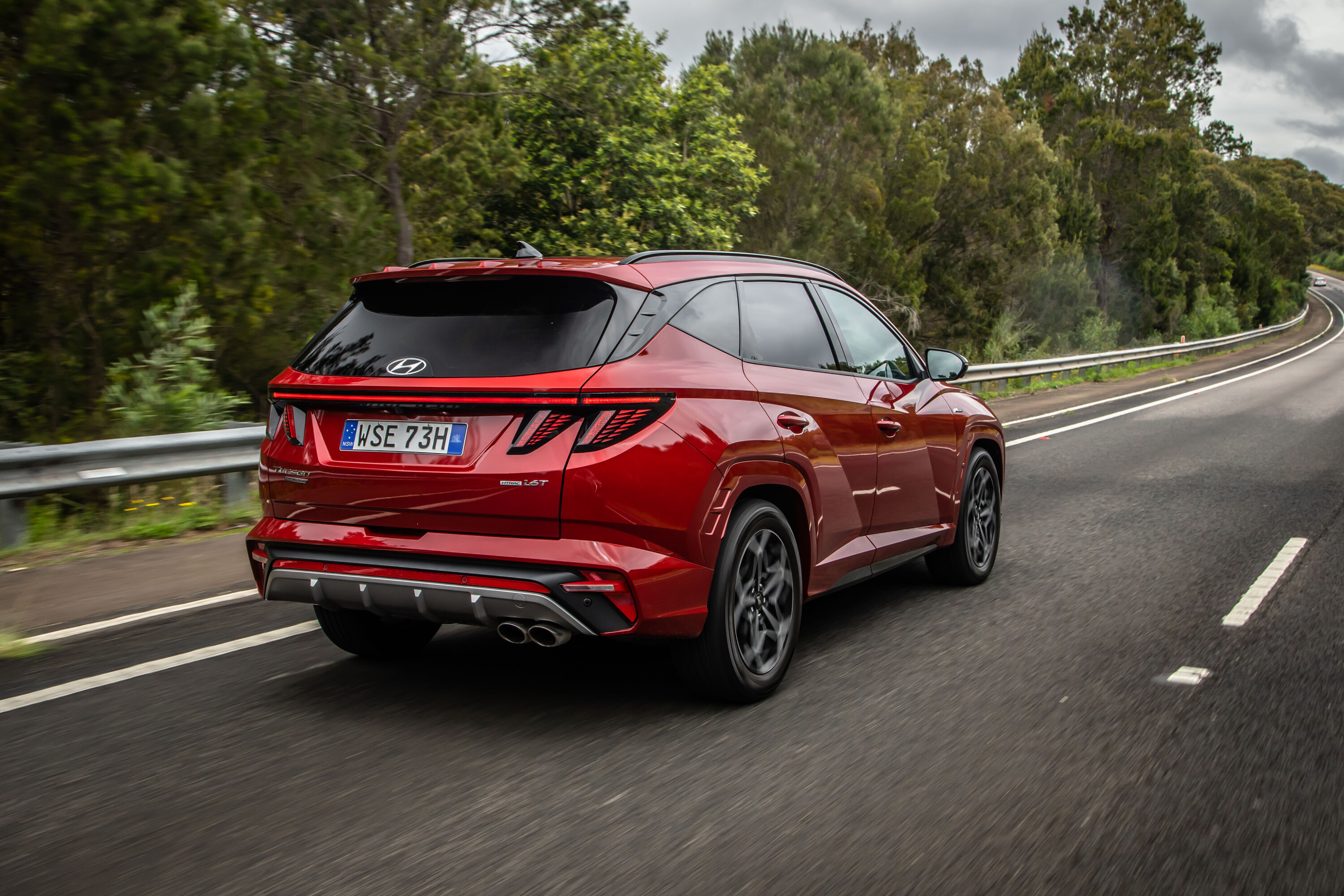
Reaching 2500rpm in quick time catches the six-speed auto napping and it seems to have trouble finding the right gear, making the engine scream at about 3500rpm for a few seconds before either finding the right cog or, if the pedal is still touching the floor, revs continue climbing to reach peak torque and power at 4500rpm and 6200rpm respectively.
That weight gain also impacts the 132kW/265Nm 1.6-litre turbo-petrol that, combined with the seven-speed dual-clutch transmission, delivers its best work at higher speeds and feels gutsy and decisive on the open road.
But around town, this powertrain combo struggles a little and can feel frustratingly slow and jerky at low speeds, not to mention a tad thirsty.
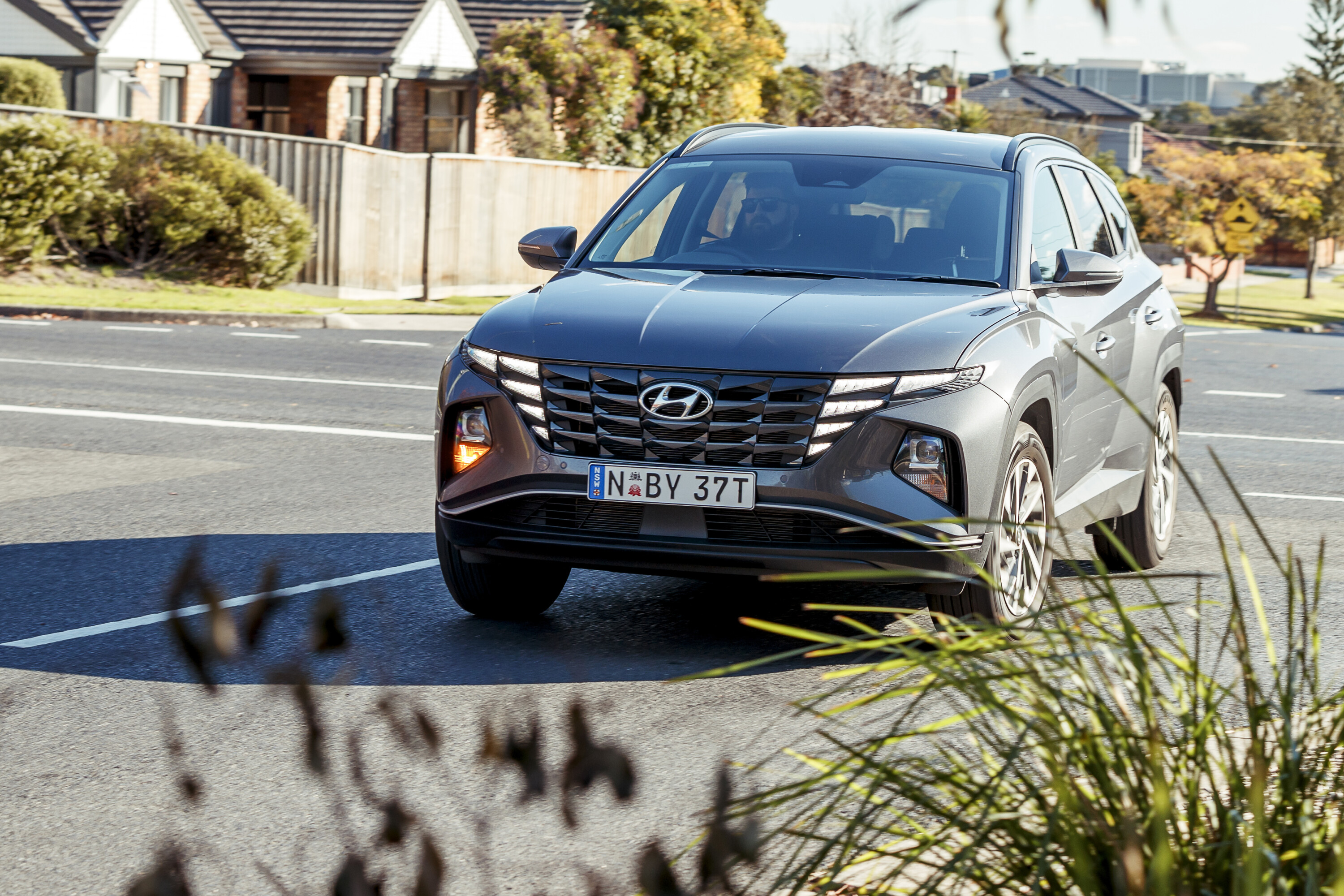
The new flagship engine, the 1.6 turbo petrol-electric hybrid, offers a more convincing 169kW and 350Nm – and that huge jump in torque makes a palpable difference behind the wheel, helped by its conventional six-speed auto.
Where the six-speed of the willing but underpowered petrol engine would desperately hold onto gears, it plays more confidently with the hybrid setup.
Ride comfort across the range is firm but not jarring – endowing the Tucson with a more sporting feel.
The new Tucson misses out on the local tune that was once a staple of Australian-delivered Hyundai models and while it cushions occupants nicely from nasty potholes, the damping is less effective at isolating the cabin from small- to medium-size bumps, making the ride feel a little busy on country roads.
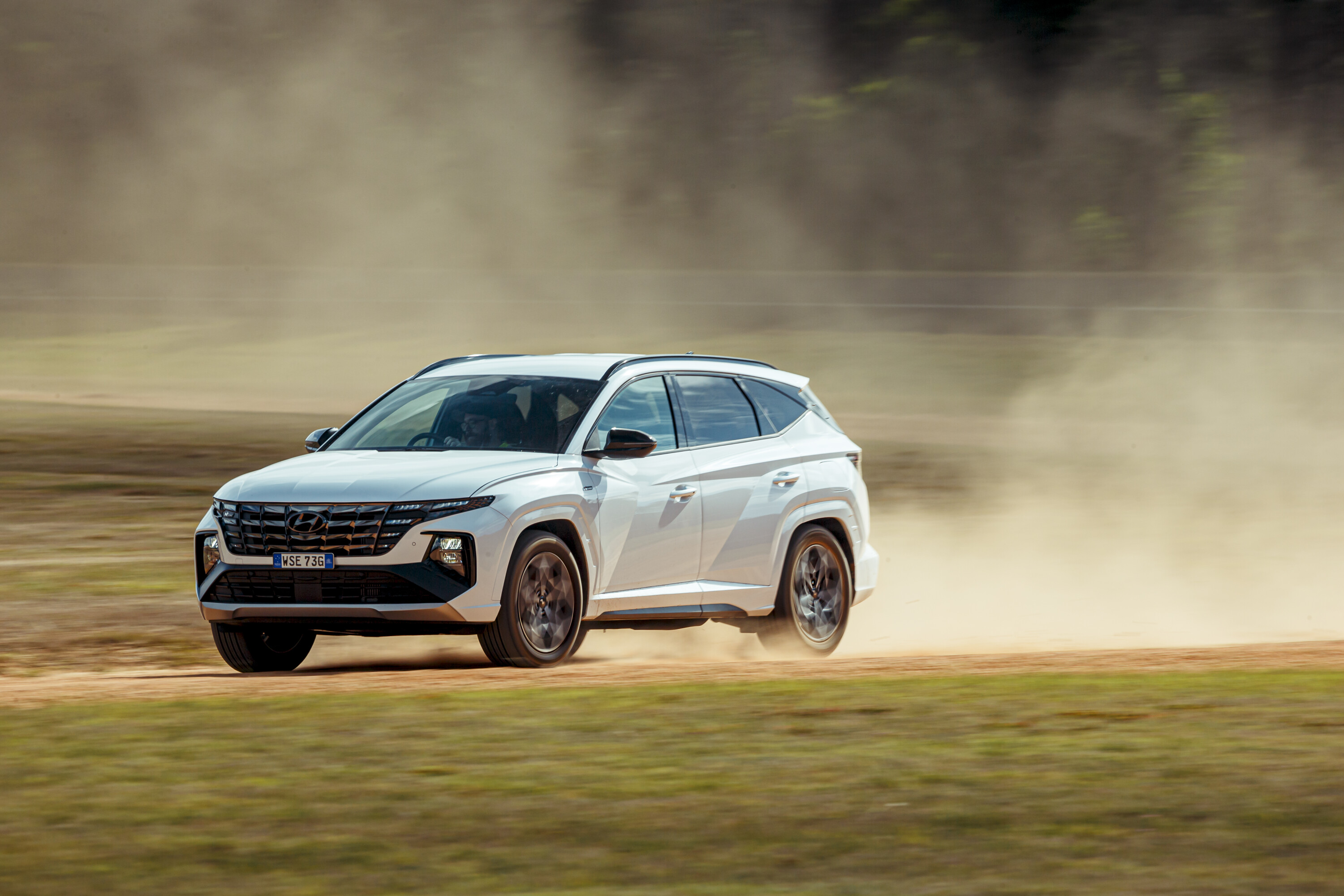
Body roll is well-contained for a medium SUV and it feels neatly compliant through corners.
The steering likewise feels well-weighted, lending more confidence in corners and on the highway.
If any of the terms in this section have left you scratching your head, these articles will help bring you up to speed!
Which Tucson engine uses the least fuel?
No surprise, the hybrid is the most frugal of the three powertrains available.
It has a respectable official combined fuel consumption rating of 5.3 litres per 100 kilometres – which, depending on the circumstances of your trip and the distance, is easily beaten with high sub-5.0 numbers. Conveniently, the hybrid only needs 91-octane petrol.
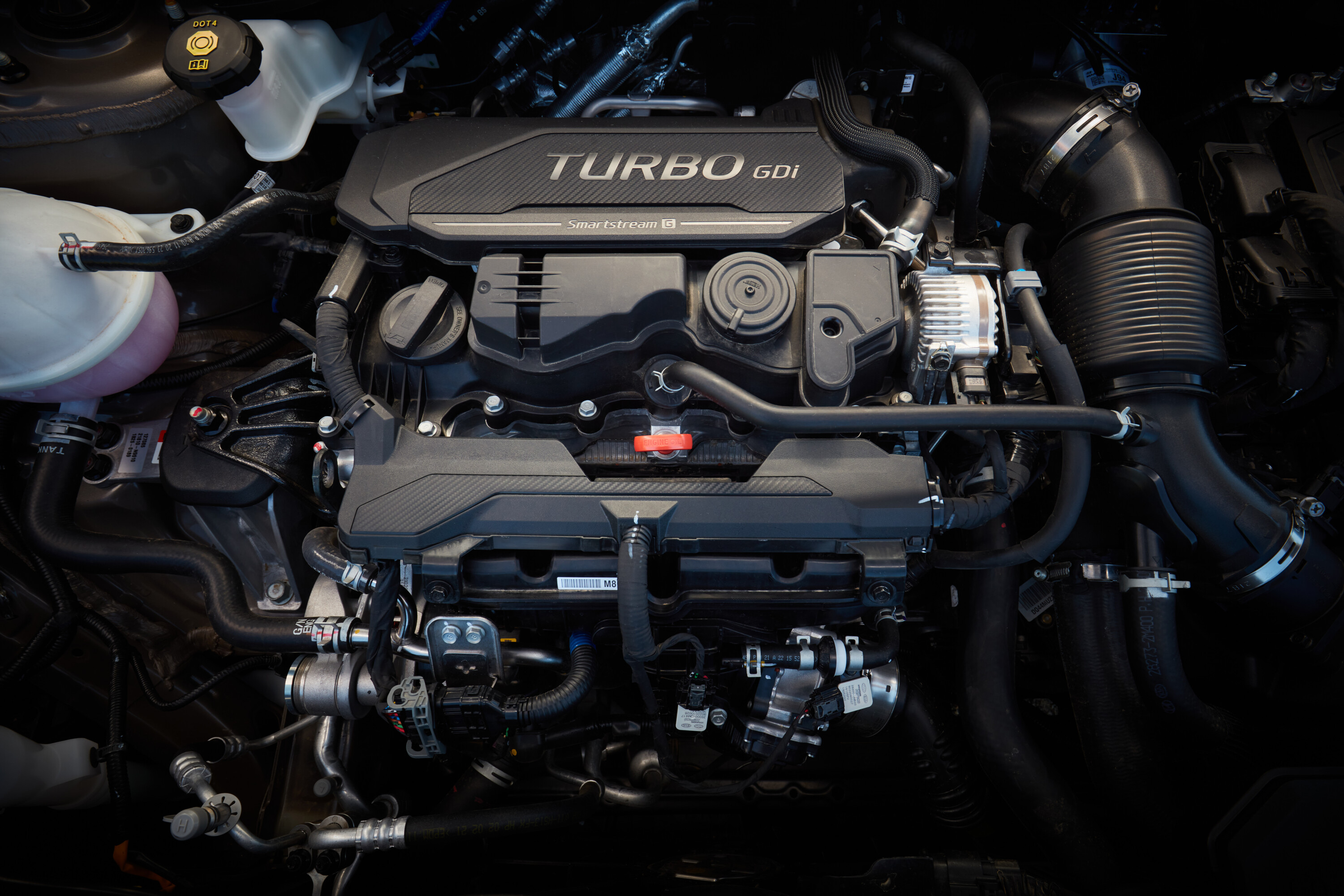
We can’t say the same about the 2.0L petrol and 1.6L turbo-petrol engines, which do a great job in a Hyundai i30 but struggle with the Tucson’s additional 200kg heft.
The 2.0-litre petrol drinks 8.1L/100km on the combined cycle and a very greedy 11.0L/100km on urban roads, while the 1.6-litre turbo engine’s official combined fuel consumption is 7.2L/100km.
What is the Tucson’s towing capacity?
The petrol Hyundai Tucsons have a 1650kg braked towing capacity, while the hybrid version can haul up to 1900 kilograms – matching the diesel model it replaces.
Unbraked towing capacity is 750kg across all three powertrains, as is the 100kg tow ball weight limit.
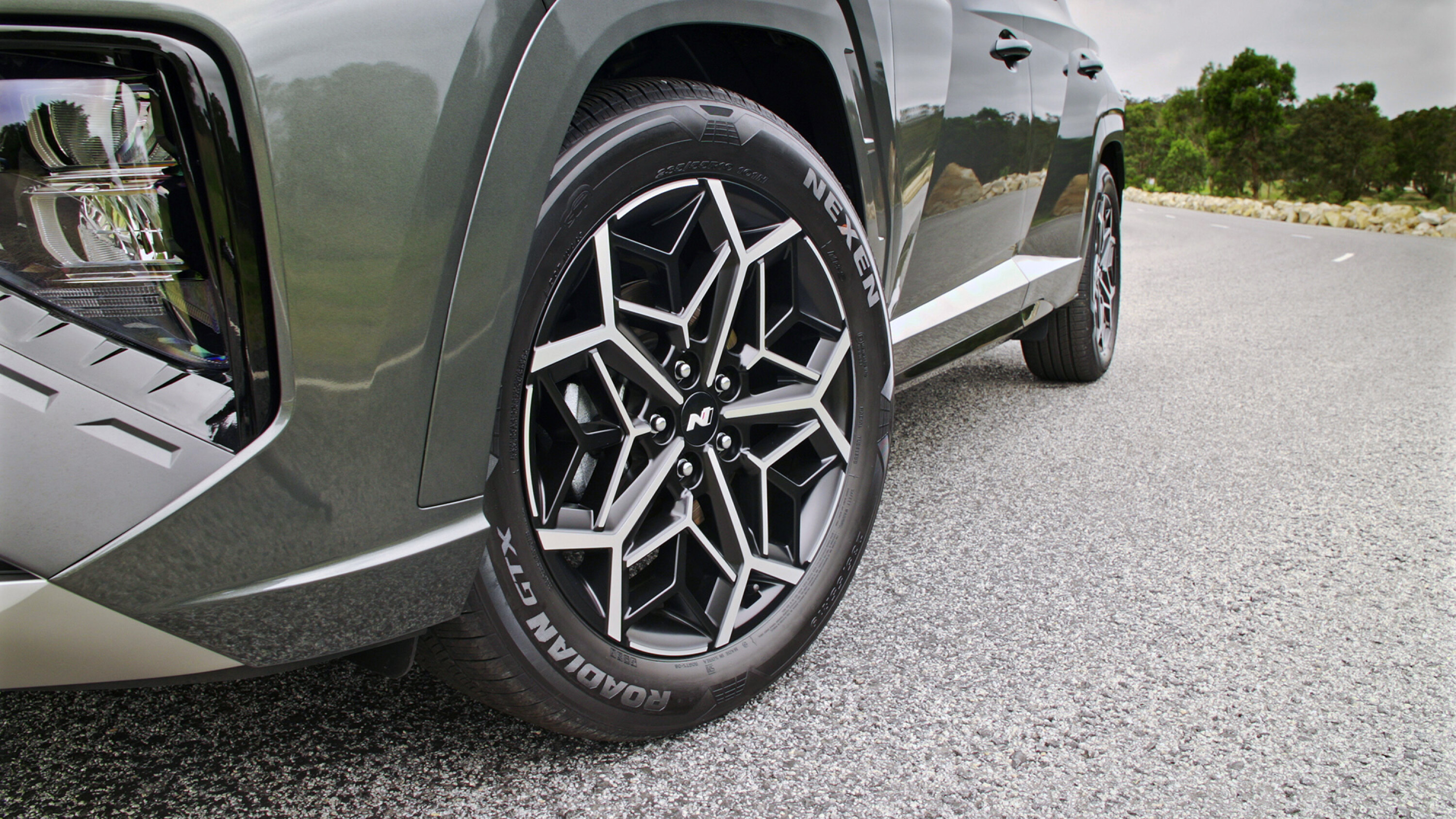
How long is the warranty and what are the Hyundai Tucson’s servicing costs?
As per the wider Hyundai range, the Tucson is covered by the brand’s five-year/unlimited-kilometre warranty.
Servicing for the 2.0-litre petrol is required every 12 months or 15,000 kilometres, whichever comes first. The turbo-petrol and hybrid variants have a shorter 12-month/10,000km interval.
Lifetime capped-price servicing is available, with costs dependent on the service interval and powertrain.
For the popular hybrid model, the first five services are priced at $340, $340, $560, $410 and $340 respectively.
Service intervals are 12 months or 10,000km – which, given the Aussie average of around 14,000km per year, could prove frustrating.
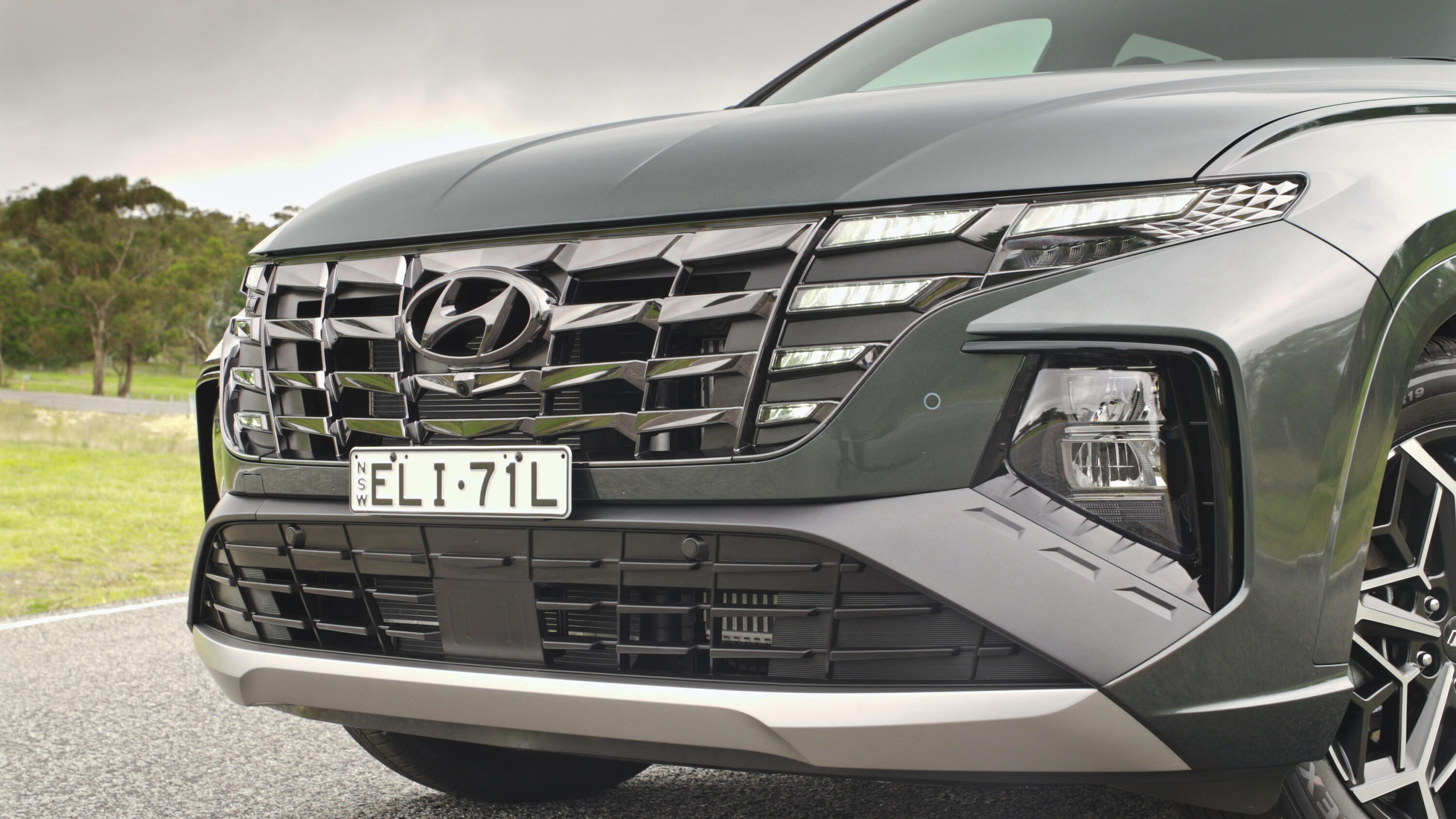
Which version of the Hyundai Tucson does Wheels recommend?
Read most Hyundai and Kia SUV reviews and you’ll be invariably steered toward the turbo-diesel AWD options in earlier forms, or the new hybrid in the Tucson’s latest incarnation.
The fact is, those combinations do a much better job of hauling these Korean SUVs than the petrol offerings. This is certainly the case with the Tucson.
For the best all-round package in the updated range, it’s hard to go past the hybrid, which offers the best value in terms of equipment, driveability, fuel economy and mid-level pricing – starting from $45,100.
What are the Hyundai Tucson’s key rivals?
Score breakdown
Things we like
- Sharp interior and exterior design
- N-Line looks even sharper
- Interior space and comfort
- Boot space and practicality
Not so much
- Lacklustre petrol powertrains
- Busy ride on country roads
- Over-zealous lane-keep assist

